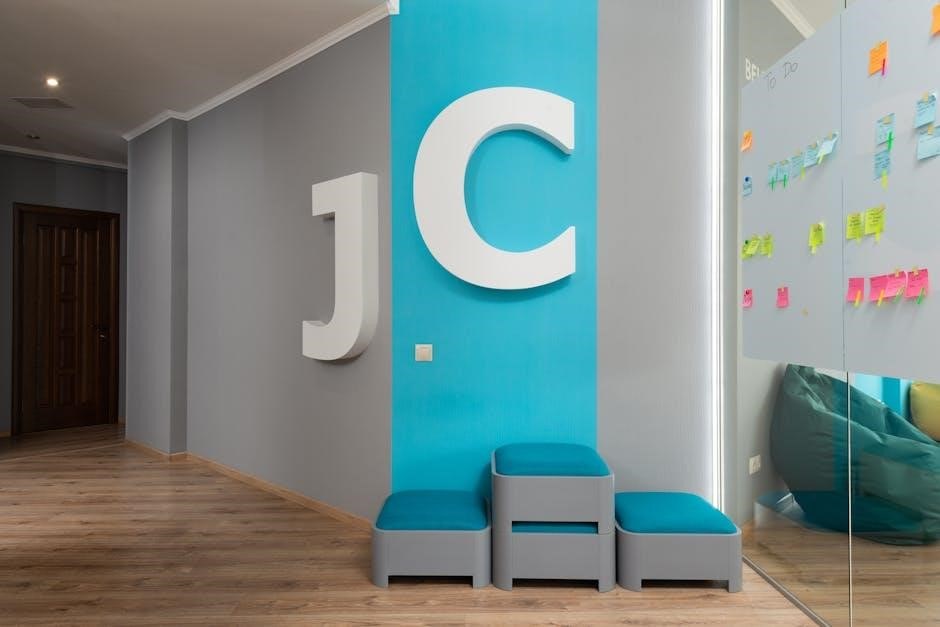A work experience letter is a formal document confirming an employee’s tenure‚ roles‚ and skills‚ serving as proof of employment for future career opportunities.
Definition and Purpose
A work experience letter is a formal document issued by an employer to confirm an employee’s tenure‚ role‚ and responsibilities. It serves as official proof of employment‚ highlighting skills‚ achievements‚ and contributions. The purpose is to validate an employee’s expertise and experience‚ aiding in future career opportunities. It also provides employers with a structured way to acknowledge an employee’s dedication and performance‚ fostering trust and credibility.
Importance for Employees and Employers
A work experience letter is crucial for employees as it validates their skills‚ performance‚ and tenure‚ aiding in job applications‚ promotions‚ or higher education. For employers‚ it fosters trust and credibility‚ showcasing their company culture. It also serves as a token of appreciation‚ enhancing employee morale and simplifying HR processes for future references. This document bridges the gap between past contributions and future opportunities‚ benefiting both parties significantly.
Structure of a Work Experience Letter
A work experience letter begins with the company’s letterhead and contact information‚ followed by the date‚ recipient details‚ certification of employment‚ job title‚ duration‚ responsibilities‚ skills‚ achievements‚ closing statement‚ and signature.
Company Letterhead and Contact Information
The letter should begin with the company’s official letterhead‚ prominently displaying the company name‚ address‚ city‚ state‚ ZIP code‚ phone number‚ and email. This ensures authenticity and professionalism‚ making it easily verifiable by recruiters or institutions. The letterhead should be centered at the top of the page‚ followed by the date and recipient details‚ maintaining a formal and standardized format for clarity and official recognition.
Date and Recipient Details
The date should be placed below the letterhead‚ typically on the left side‚ using the format “Date: MM/DD/YYYY.” Beneath the date‚ address the recipient with “To Whom It May Concern” or specify the individual’s name and title if known. Ensure clarity and formality in presenting these details to maintain the letter’s professional and official tone‚ providing a clear point of reference for verification and authentication purposes.
Certification of Employment
This section formally verifies the employee’s tenure and role‚ confirming their employment period‚ job title‚ and responsibilities. It serves as official proof of their work experience‚ detailing their contributions and skills‚ and is often signed by an authorized representative to validate its authenticity and provide a credible reference for future employers or academic institutions‚ ensuring the employee’s experience is acknowledged and respected in their professional journey.

Job Title‚ Duration‚ and Responsibilities
This section specifies the employee’s job title‚ employment duration‚ and key responsibilities during their tenure. It outlines their role‚ such as “IT Specialist” or “Sales Manager‚” and the period of employment‚ providing clarity on their contributions. Responsibilities may include managing projects‚ leading teams‚ or implementing strategies‚ offering a clear overview of their professional duties and achievements within the organization‚ which helps in showcasing their expertise and work ethic to future employers or institutions.
Skills and Achievements
This section highlights the employee’s skills and notable achievements‚ showcasing their expertise and contributions. It includes technical proficiency‚ problem-solving abilities‚ leadership qualities‚ and specific accomplishments‚ such as successfully leading projects or improving processes. This part emphasizes the employee’s value to the organization and demonstrates their capabilities‚ making it a crucial element for future career opportunities and professional growth‚ as it validates their competencies and impact during their tenure.
Closing Statement and Signature
The closing statement expresses goodwill and acknowledges the employee’s contributions. It typically wishes them success in future endeavors. Below this‚ the employer’s signature‚ name‚ and designation are included‚ authenticating the letter. This section ensures the letter ends on a professional note‚ reinforcing the employee’s positive impact and providing a formal endorsement of their work experience and skills.

Types of Work Experience Letters
Work experience letters vary by profession‚ serving as proof of employment in IT‚ teaching‚ sales‚ or creative fields‚ tailored to specific job roles and industries.
Experience Letter for IT and Hardware Specialist
This letter certifies employment of an IT and Hardware Specialist‚ detailing their tenure‚ technical expertise in managing infrastructure‚ troubleshooting‚ and implementing security protocols. It highlights their problem-solving skills and contributions to system optimization‚ ensuring seamless operations. The letter serves as formal proof of their technical proficiency and dedication‚ aiding future career opportunities in IT and related fields.
Experience Letter for Teachers
This letter verifies a teacher’s employment‚ detailing their tenure‚ subjects taught‚ and contributions to student development. It highlights their ability to create engaging lessons‚ mentor students‚ and participate in extracurricular activities. The letter confirms their dedication to education‚ collaborative spirit‚ and commitment to fostering academic excellence‚ serving as a testament to their teaching expertise and passion for nurturing future generations.
Experience Letter for Sales and Business Development
This letter validates an employee’s contributions in sales and business development‚ showcasing their role in driving growth and achieving organizational goals. It highlights skills in strategic planning‚ client relationship management‚ and meeting sales targets. The letter confirms their ability to identify opportunities‚ negotiate deals‚ and implement effective sales strategies‚ underscoring their impact on business expansion and revenue generation.
Experience Letter for Creative and Design Specialists
This letter confirms a creative specialist’s role in developing innovative designs‚ branding materials‚ and visual content. It highlights their expertise in tools like Adobe Creative Suite and Figma‚ emphasizing their ability to meet deadlines and maintain quality. The letter underscores their creative problem-solving skills and contributions to the organization’s visual identity‚ ensuring alignment with brand goals and audience expectations.

How to Write a Work Experience Letter
Include dates‚ job title‚ and duration. Highlight key responsibilities‚ skills‚ and achievements. Conclude with a professional closing and signature for authenticity.
Key Elements to Include
The letter should include the employee’s name‚ job title‚ and duration of employment. Highlight key responsibilities‚ skills‚ and achievements. Mention the company’s name and contact details. Include the start and end dates of employment. Add a professional closing statement and signature for authenticity. Ensure the tone is formal and concise‚ reflecting the employee’s contributions and expertise.
Best Practices for Customization
Customize the letter to reflect the employee’s specific role and achievements. Use company letterhead for authenticity. Ensure consistency in dates and job titles. Tailor the content to highlight relevant skills and responsibilities. Address the letter to the employee or “To Whom It May Concern.” Proofread for errors and maintain a professional tone. Include a signature from an authorized representative for validation.
Tips for Making It Professional
Use company letterhead for authenticity and include specific details about the employee’s role‚ responsibilities‚ and achievements. Ensure clarity and accuracy in dates‚ job titles‚ and descriptions. Proofread for spelling and grammatical errors. Maintain a formal tone throughout the letter. Highlight measurable accomplishments and skills relevant to the position. Include a signature from an authorized representative to validate the document. Keep the format clean and professional for a polished finish.

Eligibility Criteria for a Work Experience Letter
Employees must meet minimum tenure‚ performance standards‚ and proper separation terms to qualify for a work experience letter‚ ensuring they are eligible for certification.
Minimum Tenure Requirements
Employees typically need a minimum tenure of six months to one year to qualify for a work experience letter‚ ensuring they have sufficient time to demonstrate skills and commitment.
Performance and Conduct Standards
Employees must demonstrate satisfactory performance and adhere to company policies. Positive contributions‚ professionalism‚ and ethical behavior are essential. The letter highlights their skills and achievements‚ confirming they met expectations during their tenure.
Resignation or Separation Terms
Employees leaving voluntarily or involuntarily must meet specified terms for eligibility. The letter ensures amicable separation‚ confirming they adhered to resignation procedures and fulfilled contractual obligations‚ maintaining professional conduct until departure;
Free Downloadable Templates
Easily download professional work experience templates in Word and PDF formats. These ready-to-use samples streamline the creation process for HR and help employees present their skills effectively.
Word Format Templates
Download customizable Word templates for work experience letters‚ designed for various professions. These editable templates allow easy customization‚ ensuring a professional presentation of employment details. They include fields for company information‚ employee details‚ job roles‚ and achievements‚ making it simple to tailor the letter to specific needs. Available for IT specialists‚ teachers‚ sales professionals‚ and more‚ these templates offer flexibility and adaptability for different industries and roles.
PDF Format Templates
PDF templates for work experience letters provide a professional and standardized format‚ ideal for printing or sharing digitally. These templates are pre-designed with sections for company details‚ employee information‚ job titles‚ and tenure. They ensure consistency and a polished appearance‚ suitable for various roles like IT specialists‚ teachers‚ and sales professionals. PDF templates are easily downloadable and can be customized to meet specific requirements‚ offering a sleek and formal presentation of employment history.